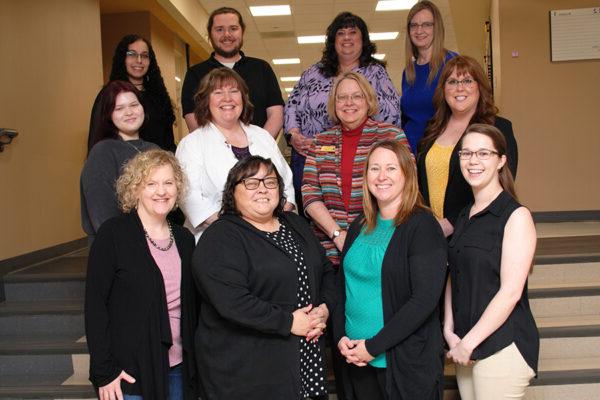Transitional Math
A pathway to begin college math
Transitional Math is a way for high school seniors to complete prerequisite math classes in preparation for college. While these classes do not officially count for college credit, they do meet prerequisite requirements. Upon completion of the class(es), students receive a “portability code” that can be used at public colleges or universities in Illinois they plan to attend.
Classes are held at the high school and in partnership with Black Hawk College, with the portability code available to other institutions for up to 18 months after graduation. BHC will also accept portability codes from other Illinois community college districts.
Information for Students & Guardians
Start with your high school counselor
Students entering 11th grade should discuss with their guidance counselor about determining their anticipated college-level readiness.
- Students projected ready will inform their counselor if they are interested in taking a fourth year of high school math. This fourth year can be Transitional Math or another 12th grade math course, such as dual credit or AP.
- Students not projected ready will inform their counselor if they choose to finish Transitional Math. Upon successful completion of Transitional Math, students will be placed into the appropriate pathway’s college-level math course at Black Hawk College (see FAQ for students). Students deciding against taking Transitional Math or students not successfully finishing the Transitional Math course will be subject to taking a placement test at Black Hawk College.
How the Pathways work
Students at the end of their first semester of 11th grade will be tentatively placed into one of the three pathways (described in FAQ for students) by their high school. Changes will be made on this placement at the end of the students’ 11th grade year, if necessary. Students with an undecided career program will be placed into the Quantitative Literacy & Statistics pathway. Students choosing to take Transitional Math in their 12th grade year will take the pathway in which they were placed.
Acquiring transcripts
The portability code will usually be located on a student’s transcript beside the course or down in an area for comments. A letter grade (not P/F) indicating a 70% or better must be reported on the transcript to be accepted. Seniors completing the entire course will be eligible for the portability code depending on which pathway was used. A summary below shows which courses qualify based on the Transitional Math portability code.
TM001 (STEM pathway)
- Math 108 Statistics for General Education
- Math 110 Math for General Education
- Math 112 College Algebra
TM002 (Quantitative Literacy & Statistics pathway)
- Math 108 Statistics for General Education
- Math 110 Math for General Education
TM003 (Technical Math pathway)
NOTE: No math offered at Black Hawk College under this pathway.
In addition to the grade and portability code, high schools must include the date that the course was completed to allow colleges to calculate an 18-month expiration date of placement.
Portability and transfer information
The lllinois State Board of Education (ISBE) and the Illinois Community College Board (ICCB) have put out requirements that high schools must apply for a portability code. Steps are outlined on this page in getting the portability code accepted. See Information for High Schools below for how to begin a Transitional Math program.
Information for High Schools
Transitional Math is part of the Postsecondary Workforce Readiness Act, or PWR Act, (Public Act 99-0674, HB 5729) in Illinois. There are three Transitional Math pathways, each designed for students who are in their junior year of high school and are not projected to be ready for college-level math. The courses are to be taken in a student’s senior year of high school after graduation requirements have been met and will guarantee placement in designated community college math courses. High schools will be required to develop and offer one or more of the three pathways in cooperation with the partner community college. A memorandum of understanding (MOU) must be signed, establishing expectations for all involved. Black Hawk College is ready to help high schools in this process.
Begin a Transitional Math program
- Reach out to Andrew Mansheim at mansheima@gw168.net to inform him that you’re prepared to begin work on your Transitional Math course.
- Select the Transitional Math pathway that best fits the needs of your students.
- Start a plan for developing the course curriculum to meet the competencies outlined by the state. You can choose to develop your own curriculum or use the sample curriculum provided by the state. You will sign a memorandum of understanding (MOU) with Black Hawk College.
- Submit your course documentation to the Local Advisory Panel in order to get approval for portability. Portability allows your students to receive placement at all community colleges across the state. Portability documents can be sent to Andrew Mansheim at mansheima@gw168.net.
High school portability information
Community colleges may submit course partnerships to a state panel for portability. This allows students who finish a Transitional Math course with a C or better to use their guaranteed placement at any community college in the state. Black Hawk College has created a local portability panel to advise on local course policy and submissions for state portability. If you are interested in helping on the panel, please contact Connie McLean (Quad-Cities Campus) at mcleanc@gw168.net or Andrew Mansheim (East Campus) at mansheima@gw168.net.
Resources
Mathematics Faculty
Quad-Cities Campus
Connie McLean
Mathematics Department Chair
mcleanc@gw168.net
East Campus
Andrew Mansheim
Transitional Math Local Advisory Panel Chairperson
mansheima@gw168.net

